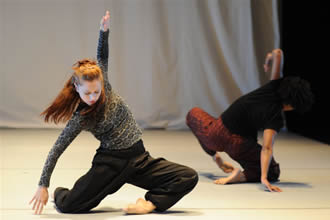The tradition of the Viennese New Year’s Eve celebration has been around for a long time, and I Iike a well-played Strauss waltz as much as the next guy, but a complete evening of these one-two-threes can leave you like having a craving for some protein after a sugar binge. Leave it to Grant Llewellyn and the North Carolina Symphony (NCS) to provide the audience with a balanced diet as well as some spectacular guest artists for an eclectic and exciting evening of music, dance, and camaraderie. It was a festive air to help usher in 2009 at Meymandi Hall, with the audience noticeably better dressed, the women in the orchestra wearing brightly colored gowns, and with subdued but effective colored lighting along the back of the stage.
The concert opened traditionally enough with one of Johann Strauss Jr.’s best-known works, the “Tritsch-Tratsch Polka.” This has the feeling of a circus march, and it is indeed a whirligig of sounds that is the perfect starter for an evening like this. This composer’s more extended and somewhat more serious Wiener Blut Waltzes followed, and that basically (and some would say thankfully) ended the New Year’s waltz/polka portion of the concert. However, since it was New Year’s Eve and dance is such a big part of the celebration, Llewellyn took the opportunity to take us on a wonderfully creative journey of the marriage of music and dance through the ages. This gave Llewellyn, an always charming and musically erudite host, the opportunity to be even more so and to serve as conductor, commentator, raconteur and all-around great showman. He first presented one of those “why hasn’t this been done before” questions regarding being able to both watch and hear some baroque dance movements that are standards of concert music. To that end, he invited four members of the North Carolina School of the Arts — Matt Foley, Emily Nicolas, Cheri Boyer, and Justin Melvin — to dance while fiddlers fiddled. First up the quartet, dressed in 18th-century French court finery, danced the minuet to the music of Jean-Philippe Rameau. Following were the two men in an athletic gigue from Bach’s Third Orchestral Suite.
Zachary DePue and Nicolas Kendall, violins, and bass player Ranaan Meyer, known collectively as Time for Three, were the special musical guests. The group formed while all were students at the Curtis Institute of Music, and they defy description and musical categorization. Classically trained with the technique that any string player would envy, they combine all styles with such enthusiasm and energy that they become a musical generator. During the evening they played some well-written works by bass player Meyer as well as a movement of a concerto written for them by acclaimed composer Jennifer Higdon. They also began playing a conventional version of Bach’s Double Concerto only to detour into their version at warp speed with touches of bluegrass and jazz. It wasn’t just the audience that was enthralled and amazed – watching the orchestra members and Llewellyn, you could see that they were equally impressed and delighted.
The second half continued the central dance theme with some decidedly un-New Year’s Eve works like Reinhold Gliere’s “Russian Sailors’ Dance,” from The Red Poppy, and the Sarabande and Galop movements from Christopher Rouse’s Friandises. This Rouse piece also served as somewhat of a commercial for the NCS’s CD, which will contain the complete work and should be released in the next month. The scheduled finale sealed the deal with a sardonic and decadently delicious “La Valse,” Ravel’s demonic paean to the waltz.
But that was just the end of the printed program, and a lot more was coming. First, Time for Three returned for a fireworks display using the “Orange Blossom Special” as their source material. Llewellyn then invited the dancers to join Time for Three for a beautiful and sensitive rendition of “Shenandoah.” While the musicians played beautifully intoned double-stop harmonies, the dancers gave Martha Graham-influenced movements that harkened back to Appalachian Spring. But this was New Year’s Eve and it wasn’t enough to end there – especially with Llewellyn in charge. He asked the audience to stand and lock arms, as is the practice in his Welsh homeland, and sing “Auld Lang Syne.” Running nearly two and one-half hours, this was a generous and brilliantly programmed and performed event. The giddy audience emptied into the cold night, already feeling good about the new year.












